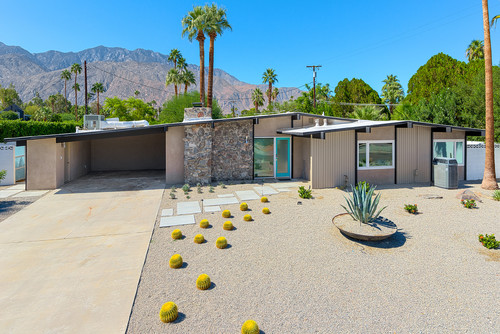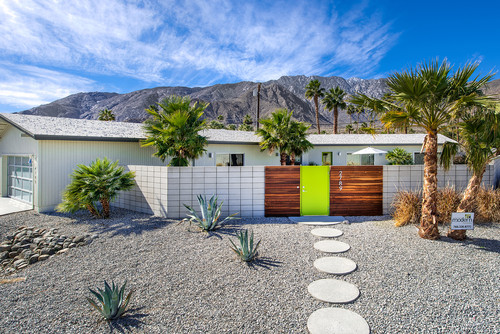11 Examples of Stunning Modern Front Yard Designs
Less is more in a modern landscape. It’s a strategy that might seem easy, but isn’t always. Every element is deliberately placed and more noticeable, so homeowners need to be thoughtful with their choices. The good news is that modern landscaping can be extremely water-wise and low maintenance.
Since the front of the home makes the first impression, we’re showcasing examples of modern front yards and highlighting the techniques that boost their curb appeal and make them noteworthy.
1. Opt for Glass Instead of Wood
The homeowner in the top photo integrated frosted glass into several gates and the garage door. This design uses more foliage than typical modern front yards, but, in this case, the plants help soften the cold look of the glass.
Glass fencing instead of wood or metal fencing is a stunning solution to enclose your space without obstructing a view.
Tempered glass won’t shatter, weathers the elements, and is easy to clean. Because glass can sometimes crack or get damaged, you’ll want to consider how to replace panels in your design if needed.
2. Incorporate Metal
Metal is a beautiful way to define a space. The architect above used custom copper raised planting beds. As copper patinas grow over time, their color becomes more striking and rich with hints of turquoise. Integrate copper throughout your yard by including copper pots, sculptures, rain chains, and rain gutters. Custom metalwork can be costly, but when used in the front yard like this, it can signal that the rest of the home may have high-end features.
3. Geometric Shapes
Almost every example on this page showcases geometric shapes in the front yard garden design. The homeowner above used a variety of poured concrete rectangles to form a walkway to the front door that better utilizes the space and creates an illusion of grandeur.
Plants are another way to incorporate geometric designs into your front yard landscaping ideas. A good rule of thumb is to plant in threes or fives. Studies have shown that our brains prefer odd-number plant placement over pairs. Arrange three plants in a triangle and groups of five in two rows, three in front and two in the back, staggering the plants so that all are visible if standing in front of the arrangement.
4. Minimalist Planting
This homeowner chose a handful of water-wise plants, placing each strategically and sporadically in groupings of more-or-less equal spacing—a common strategy in modern landscape design.
Notice how the yellow cacti sit next to the blue agave focal plant in the round container. Color contrast like this allows the groupings and plant choices to stand out more.
5. Grass Tiles in a Grid
Grass tiles make a small front yard feel larger and can be walked and driven over. Display grass tiles alongside concrete in a grid pattern of squares, rectangles, or other geometric shapes.
Grass tiles don’t have to be live grass. Artificial grass is a perfect solution for those who don’t want the hassle of mowing, fertilizing, and caring for small patches of grass. Alternatively, drought-tolerant ground covers like thyme or Dymondia work well.
6. Focal Point Plant
While it’s not mandatory, some homeowners choose one plant as a focal point in the yard. A tree, enormous succulent, or unusual plant can create the perfect focal point for your outdoor space. The homeowner above chose a single palm tree to draw the eye upward.
7. Pavers
Concrete pavers are a durable, low-maintenance way to liven up large spaces like driveways and patios. Pavers come in a variety of patterns and colors. Opt for clean lines and muted tones for your modern home.
If you’re a homeowner looking for a bit of green in your front yard, Turfstone pavers are another option. These pavers are latticed, providing open space to grow vegetation inside while allowing rainwater to filter through. This eco-friendly solution softens modern front yards that feature mostly decorative stone and hardscapes. Homeowners can also fill Turfstone spaces with pea gravel or small rocks instead of grass.
8. Decorative Stone
Modern yard design incorporates a variety of textures and often uses one or more types of decorative rock. White marble, blue river stones, and pea gravel are used alone or as mulch around beautiful succulents, such as in the design above.
9. Pops of Color
Flanked by fencing with rich horizontal wooden planks and circular stepping stones, this entry with a lime green door is certainly eye-catching. A brightly colored door can add visual appeal to your entryway and break up the neutral colors of modern design.
Colorful window boxes or a few well-placed flowering plants can also add color to your house exterior. When choosing flowering plants, consider perennials over annuals so you don’t have to replant yearly.
10. Clever Lighting
This row of cacti is quite striking during the day, but the homeowner kicked it up a notch by spotlighting each one for a dramatic nighttime view. The ambient light likely serves a dual purpose of guiding people to the front door at night. The tree lit up on the other side of the walkway balances the lighting.
11. Water Feature
Incorporating a water feature enhances the look of any outdoor space. A tiered fountain or waterfall adds visual beauty and the serene sound of falling water.
Frequently Asked Questions About Modern Front Yard Landscape Design
What is modern landscape design?
Modern landscape designs are minimalist, incorporating sharp lines and geometric designs. They use simple materials like wood, concrete, and metal to create a clean, uncluttered look.
What is the average cost of modern front yard landscaping?
Modern front yard landscaping costs vary depending on the size of your yard, the type of projects you want to implement, and the materials you choose. Landscaping costs range from $4.50 to $17 per square foot or $50 to $100 per hour. Most homeowners spend an average of $8,150 on landscaping projects.
What can I do to make my front yard look like a resort?
Resorts are luxurious and relaxing, and with just a few design elements, you can create a resort feel in your front yard. Designing around a theme can keep everything cohesive, so choosing a modern landscape design is an excellent start to streamlining your design plans.
Create a patio lounge, opting for luxe seating. A daybed or hanging swing bed on the front porch can be a cozy seating area that doubles as a focal point. A fence or privacy hedges can create a calm, secluded relaxing space.
Large plants in bold colors make a statement and curate the energy of a space. Soft lighting, like lanterns and accent lighting, can illuminate trees and create a nice night time ambiance. A water fountain or waterfall looks elegant and greets you with the peaceful sound of running water.
Numerous features could elevate your front yard; these are just a few design ideas for starting.
Install-It-Direct brings your dream front yard design to reality
Whether you have a clear vision or a few ideas, Install-It-Direct can help make your dream front yard a reality. Get a free estimate, and we can start designing the front yard you’ll enjoy for many years to come.
Your Turn…
What are your favorite elements of a modern front yard?








